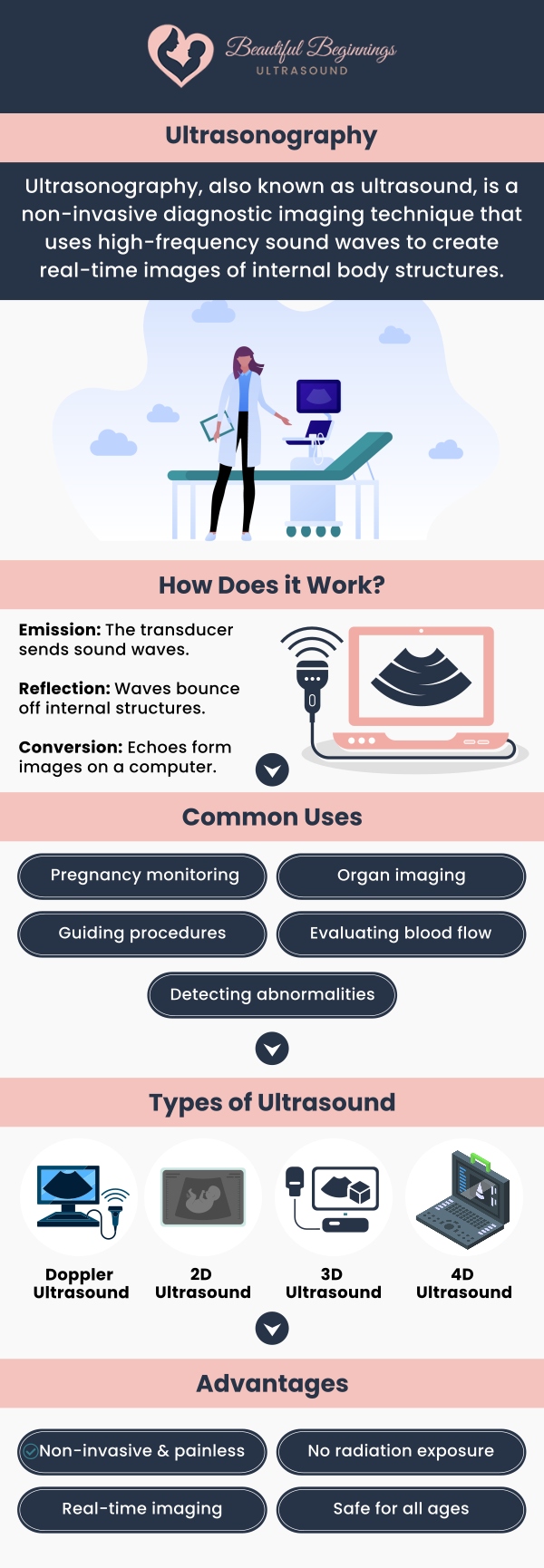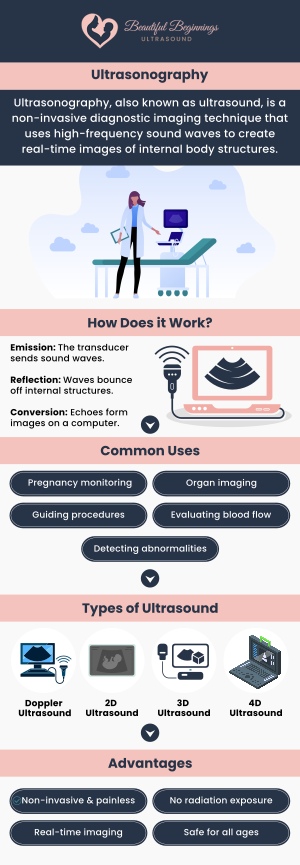Types of Ultrasound Imaging in Shrewsbury, NJ
Ultrasound technology has revolutionized the field of medical imaging, allowing doctors to see inside the human body without invasive procedures. Ultrasounds are used to diagnose a wide range of medical conditions, from pregnancy to cancer. Visit Beautiful Beginnings Ultrasound Clinic today to get specialized and comprehensive care. For more information, contact us today or book an appointment online. We are conveniently located at 180 Ave at the Cmns Suite 9, Shrewsbury, NJ 07702.




Table of Contents:
How many types of ultrasounds are there?
Which type of ultrasound is more accurate?
When is an ultrasound scan used?
Are there any risks with an ultrasound?
A transabdominal ultrasound is a non-invasive imaging technique that uses high-frequency sound waves to create images of the organs and tissues in the abdomen. This type of ultrasound is performed externally, by placing a transducer on the skin of the abdomen. Transabdominal ultrasounds are commonly used to diagnose conditions such as gallstones, liver disease, and abdominal tumors. During a transabdominal ultrasound, a gel is applied to the skin of the abdomen to help transmit the sound waves. The transducer is then moved over the skin to capture images of the organs and tissues in the abdomen. The sound waves bounce off the organs and tissues and are picked up by the transducer, which sends the information to a computer to create the images. A transabdominal ultrasound is a safe and painless procedure that can provide valuable information about the health of the organs and tissues in the abdomen. It is often used in conjunction with other imaging techniques, such as CT scans and MRI scans, to provide a more complete picture of a patient’s condition.
Transvaginal ultrasounds are a type of ultrasound that is performed internally, by inserting a transducer into the vagina. This type of ultrasound is commonly used to diagnose conditions such as ovarian cysts, uterine fibroids, and pelvic inflammatory disease. During a transvaginal ultrasound, a gel is applied to the transducer, which is then inserted into the vagina. The transducer emits high-frequency sound waves, which bounce off the organs and tissues in the pelvic area. The sound waves are picked up by the transducer and sent to a computer to create images of the organs and tissues. Transvaginal ultrasounds are a safe and painless procedure that provides valuable information about the health of the reproductive organs. It is often used to monitor pregnancy and to diagnose conditions such as endometriosis and polycystic ovary syndrome.
Doppler ultrasounds are a type of ultrasound that is used to evaluate blood flow in the arteries and veins. This type of ultrasound is commonly used to diagnose conditions such as deep vein thrombosis, peripheral artery disease, and carotid artery disease. During a Doppler ultrasound, the transducer emits high-frequency sound waves that bounce off the red blood cells in the arteries and veins. The sound waves are then picked up by the transducer and sent to a computer to create images of the blood flow.
Ultrasounds are a widely used imaging technique that has revolutionized the field of medical diagnosis. It is a non-invasive and safe procedure that uses high-frequency sound waves to create images of internal organs and tissues. Two types of ultrasounds are commonly used in medical practice: transabdominal and transvaginal ultrasound. Both types have their unique advantages and limitations, and choosing the right type for a particular medical condition is crucial for accurate diagnosis.
Transabdominal ultrasounds are a type of ultrasound that is performed by placing a transducer on the abdomen of the patient. The transducer emits high-frequency sound waves that penetrate the body and create images of the internal organs. One of the main advantages of a transabdominal ultrasound is that it is a non-invasive and painless procedure that does not require any special preparation. It is also a relatively quick procedure that can be performed in a doctor’s office or clinic. However, transabdominal ultrasounds have some limitations and disadvantages. For instance, they may not provide clear images in obese patients or patients with a lot of gas in their intestines. Additionally, they may not be suitable for diagnosing certain medical conditions, such as ovarian cysts or fibroids.
Transvaginal ultrasounds, also known as endovaginal ultrasounds, are a type of ultrasound that is performed by inserting a transducer into the vagina. This type of ultrasound provides more detailed images of the pelvic organs and is particularly useful for diagnosing conditions such as endometriosis, ovarian cysts, and uterine fibroids. One of the main advantages of a transvaginal ultrasound is that it provides clearer images of the pelvic organs than transabdominal ultrasounds. It is also more accurate in diagnosing certain medical conditions. However, transvaginal ultrasounds are an invasive procedure that may cause discomfort and embarrassment for some patients.
When comparing transabdominal and transvaginal ultrasounds, several factors need to be considered, including accuracy, patient experience, and cost. In terms of accuracy, a transvaginal ultrasound is generally more accurate than a transabdominal ultrasound in diagnosing conditions such as ovarian cysts and endometriosis. However, transabdominal ultrasounds are more suitable for diagnosing conditions such as gallstones or liver diseases. In terms of patient experience, transvaginal ultrasounds may cause discomfort and embarrassment for some patients, while a transabdominal ultrasound is generally painless and non-invasive. Finally, the cost of the two types of ultrasounds may vary depending on the location and the provider. Generally, transvaginal ultrasounds are more expensive than transabdominal ultrasounds due to the need for specialized equipment and trained personnel.
Ultrasound scans use high-frequency sound waves to create images of structures inside the body. Doctors typically use an ultrasound to examine a developing fetus (unborn child), a person’s abdominal and pelvic organs, muscles and tendons, or the heart and blood vessels.
Ultrasounds are a valuable tool, but they have their limitations. Sound waves don’t travel well through air or bone, so ultrasounds cannot effectively image parts of the body that contain gas or are obscured by bone, such as the lungs or head. Ultrasounds may also not be able to detect objects located deep within the human body. To check these areas, your doctor may order other imaging tests, such as a CT, MRI scan, or an X-ray.
Diagnostic ultrasounds are a safe procedure that uses low-power sound waves. There are no known risks.
Visit Beautiful Beginnings Ultrasound Clinic today to get specialized and comprehensive care. For more information, contact us today or book an appointment online. We are conveniently located at 180 Ave at the Cmns Suite 9, Shrewsbury, NJ 07702. We serve patients from Shrewsbury NJ, Red Bank NJ, Little Silver NJ, Eatontown NJ, Middletown NJ, Colts Neck NJ, Rumson NJ, Holmdel NJ, Long Branch NJ, West Long Branch NJ, Ocean City NJ, Oceanport NJ, and Surrounding Areas.

Check Out Our 5 Star Reviews


Additional Services You May Need
▸ 3D Ultrasound Imaging
▸ 4D Ultrasound Imaging
▸ 5D Ultrasound Imaging
▸ 3D and 4D Ultrasound
▸ Elective Ultrasound
▸ Early Gender Determination
▸ Prenatal Ultrasound
▸ Ultrasound Imaging
▸ Ultrasound Scans
▸ 12k Imaging

Additional Services You May Need
▸ 3D Ultrasound Imaging
▸ 4D Ultrasound Imaging
▸ 5D Ultrasound Imaging
▸ 3D and 4D Ultrasound
▸ Elective Ultrasound
▸ Early Gender Determination
▸ Prenatal Ultrasound
▸ Ultrasound Imaging
▸ Ultrasound Scans
▸ 12k Imaging



